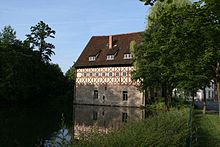Rosenauer Castle
| Rosenauer Castle | ||
|---|---|---|
|
Rosenauer Castle |
||
| Creation time : | 1397 (first) | |
| Castle type : | Moated castle | |
| Conservation status: | receive | |
| Standing position : | Knight's castle | |
| Construction: | Truss | |
| Place: | Coburg | |
| Geographical location | 50 ° 15 '50 " N , 10 ° 58' 2" E | |
|
|
||
The Rosenauer Castle , located in Coburg between Rosenauer Straße and Hahnweg on the Rittersteich , was first mentioned as a castle in 1397, and in 1426 as the house of the mint master. In 1434 the Lords of Rosenau probably initiated the construction of the moated castle . After being thoroughly razed , used as a fish, laundry and warehouse and gradually decaying into the 20th century, it is today one of the gems of historical architecture in Coburg, restored in an exemplary manner.
history
Original building
The mint masters Ritter Heinz and Günter von Rosenawe, whose title of nobility had been temporarily revoked until 1433 due to improper lifestyle , built Rosenau Castle as a moated castle not far from the outer fortifications of the city of Coburg after Rosenau Castle in Oeslau in 1434 . During that time, the brothers were given the right to strike Coburg coins . Her ancestor, the mint master Friedrich von Ouwe, who was already known in 1394, certainly came from this knightly family who held this office in Bamberg as early as 1250.
The Hahn River , then still called the Hain River, fed the knight's pond that completely encompassed the castle. The western side of the pond facing the Hahnmühle was spanned by a stone bridge with two small corner towers, the end of which on the castle side was a wooden drawbridge . The actual, rectangular main building, the Palas , was bordered by two Gothic stepped gables and on the side of the bridge provided with two corner towers through which one could get to the upper floor. The four-storey, mighty building made of sandstone was decorated with bay windows on the gable ends and a porch protruding into the knight's pond.
Remodeling and decay
Martin von Rosenau, the last owner of the knight family, sold the property to Christoph von Hessberg in 1556. In 1611 Duke Johann Casimir bought the indebted property. In 1671 it was removed down to the lower floor. A storey and a mighty saddle roof in beautiful ornamental framework were placed on the remains of the palace . As a result, the ducal brewery was housed in the building. The Hoffischer lived upstairs. In 1700 and 1773 the former castle was called the Princely Fish House. The bridge was demolished in 1842 and the pond was filled in except for a small part that is still there today.
At the beginning of the 19th century, drastic alterations were made again. The windows on the upper floor and in the roof gable were enlarged and the framework was plastered without taking into account the existing beam position of the rare Franconian K in the framework. From then on, the building served as a wash house for the ducal family and was popularly known as that.
Todays use
After the Second World War , the building served the State Theater for a time as a set , furniture and prop store until it was emptied and left to decay. At the end of the 1970s, the Free State of Bavaria, owner since 1919, had the castle on Rittersteich completely renovated, and its Franconian half-timbering exposed and restored. The building management of the Bamberg State Building Authority has had offices in the building for several years . Since the beginning of 2013, the Criminal Police Advice Center of the Coburg Criminal Police Office has been located on the ground floor of the building.
literature
- Fritz Mahnke: Palaces and castles around the Franconian Crown , printing and publishing house Neue Presse GmbH, Coburg, 1974, pp. 11-13
- Peter Morsbach, Otto Titz: City of Coburg. Ensembles-Architectural Monuments-Archaeological Monuments . Monuments in Bavaria . Volume IV.48. Karl M. Lipp Verlag, Munich 2006, ISBN 3-87490-590-X


